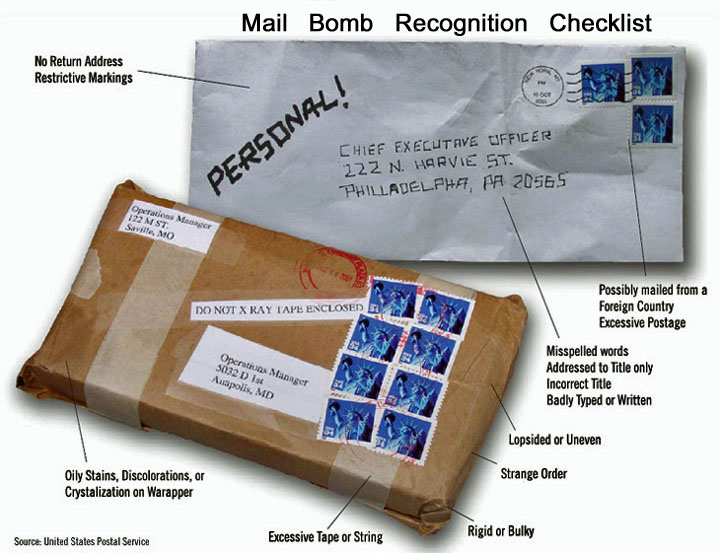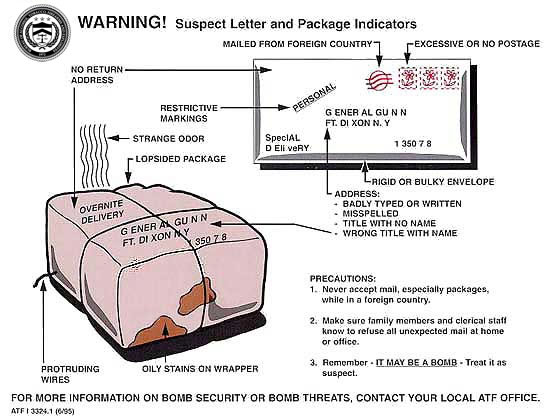Threatening Individuals

Active Shooter
HOW TO RESPOND WHEN AN ACTIVE SHOOTER IS IN YOUR VICINITY:
Quickly determine the most reasonable way to protect your own life. Remember that customers and clients are likely to follow the lead of employees and managers during an active shooter situation.
1. Evacuate
If there is an accessible escape path, attempt to evacuate the premises. Be sure to:
• Have an escape route and plan in mind
• Evacuate regardless of whether others agree to follow
• Leave your belongings behind
• Help others escape, if possible
• Prevent individuals from entering an area where the active shooter may be
• Keep your hands visible
• Follow the instructions of any police officers
• Do not attempt to move wounded people
• Call 911 when you are safe
2. Hide out
If evacuation is not possible, find a place to hide where the active shooter is less likely
to find you. Your hiding place should:
• Be out of the active shooter's view
• Provide protection if shots are fired in your direction (i.e., an office with a closed
and locked door)
• Not trap you or restrict your options for movement
To prevent an active shooter from entering your hiding place:
• Lock the door
• Blockade the door with heavy furniture
If the active shooter is nearby:
• Lock the door
• Silence your cell phone and/or pager
• Turn off any source of noise (i.e., radios, televisions)
• Hide behind large items (i.e., cabinets, desks)
• Remain quiet
If evacuation and hiding out are not possible:
• Remain calm
• Dial 911, if possible, to alert police to the active shooter's location
• If you cannot speak, leave the line open and allow the dispatcher to listen
3. Take action against the active shooter
As a last resort, and only when your life is in imminent danger, attempt to
disrupt and/or incapacitate the active shooter by:
• Acting as aggressively as possible against him/her
• Throwing items and improvising weapons
• Yelling
• Committing to your actions
Lane Lockdown Video for Active Shooters
Run. Hide. Fight. Active Shooter Video
Department of Homeland Security Active Shooter Brochure
Violent Or Threatening Behavior
Your first duty is to ensure the safety of yourself and those you are responsible for at the college. Do not meet with anyone who has threatened you or is an obvious danger to you.
For situations that pose an immediate threat of danger call (541) 463-5555 or (541) 463-5558. Refer persons who pose a potential threat to either your manager, HR, or the campus judicial system.
 Verbally Abusive Behavior
Verbally Abusive Behavior
1. Remain calm. Try to calm the person down.
2. Try to listen carefully and pay attention to what is said. Let the person know you will help within your ability to do so.
3. If the individual does not respond, get the attention of others around you.
4. Notify the counselor in your area, or contact Counseling at (541) 463-8888.
5. If the situation is escalating or if you feel there is an immediate threat, contact Public Safety at (541) 463-5555 or (541) 463-5558.
6. If necessary, leave your workspace. Do so under whatever pretext is necessary.
Physically Aggressive Behavior
1. Do not engage the physically aggressive person. Leave your workspace immediately. Go to a location with other people.
2. Advise your manager and other staff.
3. Call Public Safety at (541) 463-5555 or (541) 463-5558.
Other Guidelines for Coping in a Potentially Violent Situation
1. Alert a colleague that you will be meeting with a potentially violent person and have the colleague ready to assist. Have a public safety officer "on call" or with you as circumstances dictate.
2. Keep the door of your meeting place open and position yourself in an area that gives you an easy exit.
3. Be aware of and remove any object that could be used as a weapon, if safe to do so.
4. If your instinct tells you something is wrong, leave immediately.
5. Avoid body language that appears challenging such as placing your hands on your hips, moving into the other person's territory or using aggressive facial expressions.
6. Slow your speaking rate and lower your voice to de-escalate the situation.
7. Ask to include a supervisor or administrator to help the agitated person's need to feel heard.
8. Ask questions to help regain control of the conversation and to understand the situation.
9. Never agree with disoriented statements or attempt to argue. Avoid defensiveness.
10. End the conversation if the person remains belligerent and does not respond to your efforts.
11. Never touch an outraged person or try to force them to leave.
12. If a weapon becomes evident, leave. If that is not possible, calmly ask the person to leave any weapon in a neutral position as you continue talking calmly. Notify Public Safety as soon as possible.
13. Let the person know the consequences of any violent behavior.
14. Never agree to go to an unmonitored location with a potentially violent person.
15. After the meeting is over, report any unacceptable behavior or threats to your manager and Public Safety. Help the campus remain alert to any situation that could eventually escalate to violence.
Other Threatening Situations
- Psycological and Emotional Trauma
- Suicide Prevention
- Suspicious Package, Envelope or Object
- Demonstrations and Protests
Psychological And Emotional Trauma
There is a likelihood for mental health trauma or psychological trauma in the event of an emergency or traumatic incident where there are victims or witnesses. Support services are offered through Lane's Counseling Department (541) 463-3200. The Counseling Department networks with other agencies in the community and will call for additional support if needed.
Types of Support
There are three basic supports which are provided at the scene:
1. Assistance to victims, survivors and family members who are directly involved with the incident;
2. Brief crisis interventions with emergency personnel who are showing signs of distress; and
3. Advice and counsel to the Emergency Planning Team.
Action Steps
1. Your first duty is to ensure your own safety.
2. Call Public Safety at (541) 463-5555 or (541) 463-5558 to make sure they are aware of the situation.
3. Next, if you believe you can and desire to, assess the emotional state of those around you and determine if you can safely help stabilize them emotionally while you wait for professional assistance to arrive.
4. When help arrives, trained crises responders will assess the nature and extent of the intervention that is called for and take over responsibility for stabilizing the situation and providing crisis management.
5. If necessary they will notify the president or designee with recommendations.
6. Outside assistance will be requested if warranted by the situation.
7. For students, counseling is available by making an appointment by calling (541) 463-3200 or dropping by the counseling department (Building 1, Room 103) any time during regular business hours.
8. For employees, the Employee Assistance Program (EAP) is available at (541) 344-6929.
Suspicious Package, Envelope, or Object
• Examine unopened envelopes and packages and look for suspicious features.
• Handle incoming mail in a designated separate mailroom.
• Wash your hands after mail is opened.
• Restrict mailroom access to authorized persons.
• Remain calm.
• Do not open the package or letter.
• Do not shake or empty the contents of a suspicious package or envelope.
• Do not carry the package or envelope, show it to others or allow others to examine it.
• Put the package or envelope on a stable surface; do not sniff, touch, taste, or look closely at it or any contents that may have spilled.
• Do not touch your eyes, nose or other body parts.
• Shut off window air conditioning units and fans.
• Isolate the package and secure the room by shutting all doors and windows.
• Thoroughly wash hands with soap and water.
• If in or near a federal facility, contact the Federal Protective Service by calling (877) 437-7411.
• Report to supervisor and call 911.
• Advise fellow co-workers to avoid the area.
• Don't leave the area until told to by responding officers.
• Ensure that all persons who have touched the letter wash their hands with soap and water.
• Make a list of all persons who touched the letter or package and who were in the area when the letter was opened.
• After examination of package, shower with soap and water.
Response Checklist for Suspicious Mail
Features of Suspect Mail

- No return address or fictitious return address
- Excessive postage, no postage, or non-canceled postage
- Improper spelling of names, titles or locations
- Unexpected envelopes from foreign countries
- Suspicious or threatening messages written on packages
- Postmark with different location than return address
- Distorted handwriting or cut-and-paste lettering
- Unprofessionally wrapped packages or excessive use of tape, strings, or other wrapping
- Packages marked "Fragile: Handle with Care," "Rush: Do Not Delay," "Personal" or "Confidential"
- Rigid, uneven, irregular, or lopsided packages
- Packages discolored, oily or with an unusual odor
- Packages with soft spots, bulges, or excessive weight
- Protruding wires or aluminum foil
See Something, Say Something Video
Video courtesy of iWatchHouston, and The Department of Homeland Security
Demonstrations and Protests
Demonstrations, protests or work stoppages can have various consequences for the college. They can adversely affect the normal delivery of educational services. These events can also pose a threat to the safety and security of students and staff when coming to, using and departing from college property.
A demonstration or protest is considered a planned event if the college has been notified and the event appropriately scheduled. The Public Safety Manager will coordinate with local authorities to ensure access to and from the college, and will request any necessary assistance to ensure students, employees and properties are provided the highest degree of protection available. Every effort will be made to maintain a positive learning environment.
If an event occurs without notice, the college will take all necessary actions to maintain normal operating activities. The Public Safety Manager will coordinate with appropriate law enforcement and judicial officials to obtain support for the protection of college students, employees and property as soon as possible.
1. If you observe unapproved demonstrations or protests or if they are taking place at unapproved locations, contact Public Safety at (541) 463-5555 or (541) 463-5558.
2. If you are not comfortable with what is being said, do not stay in the area. Avoid provoking or obstructing demonstrators.
3. In the event of a civil disturbance continue with your normal routine as much as possible. If the disturbance is outside, stay away from doors and windows.
4. If you observe destructive behavior at any time contact Public Safety at (541) 463-5555 or(541) 463-5558. Give your name and what you saw.
5. Leave immediately if violent behavior is observed and proceed to your workspace or an area away from the demonstration. Advise the appropriate manager and then wait for instructions.
6. If you are on campus after hours and no one is available from your department or division, contact Public Safety at (541) 463-5555 or (541) 463-5558.
